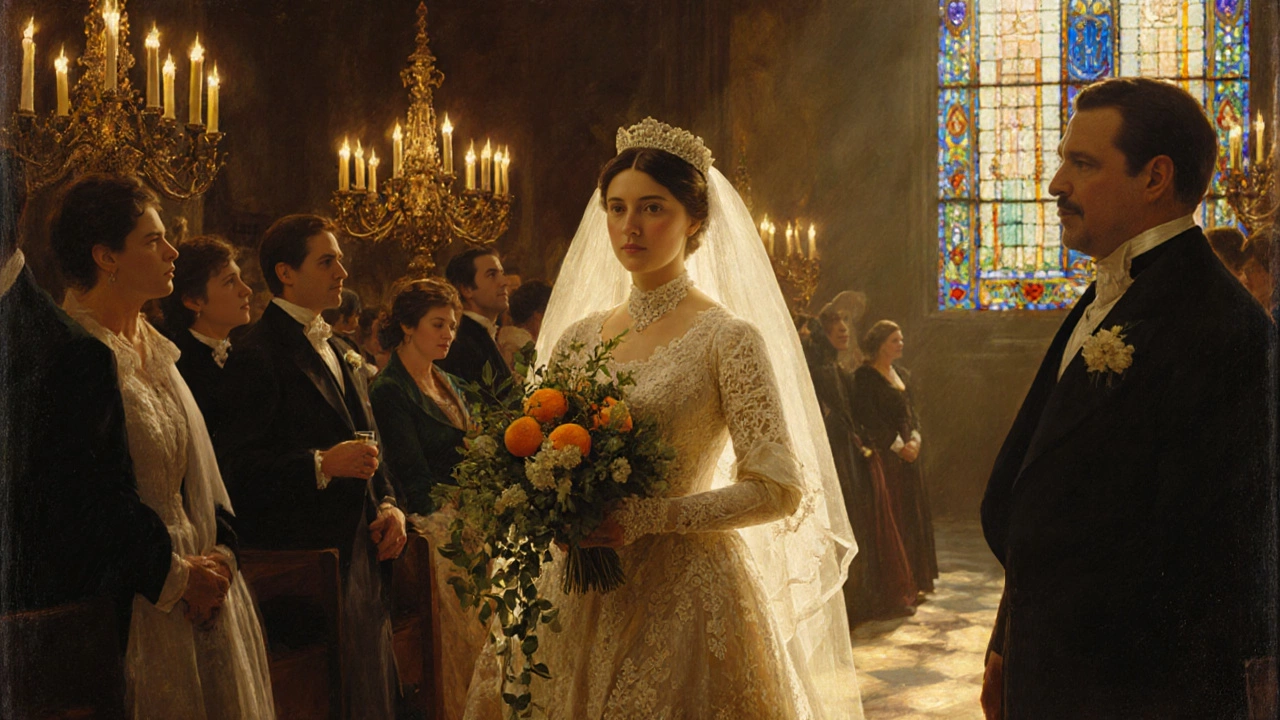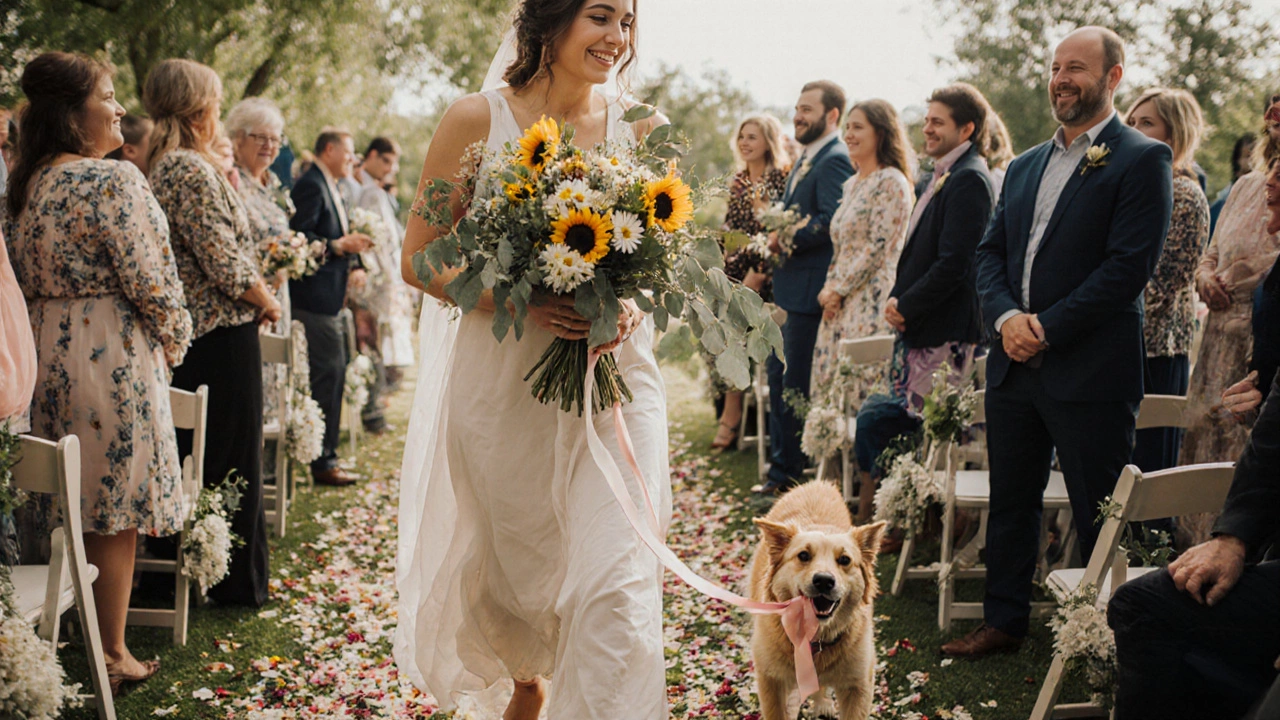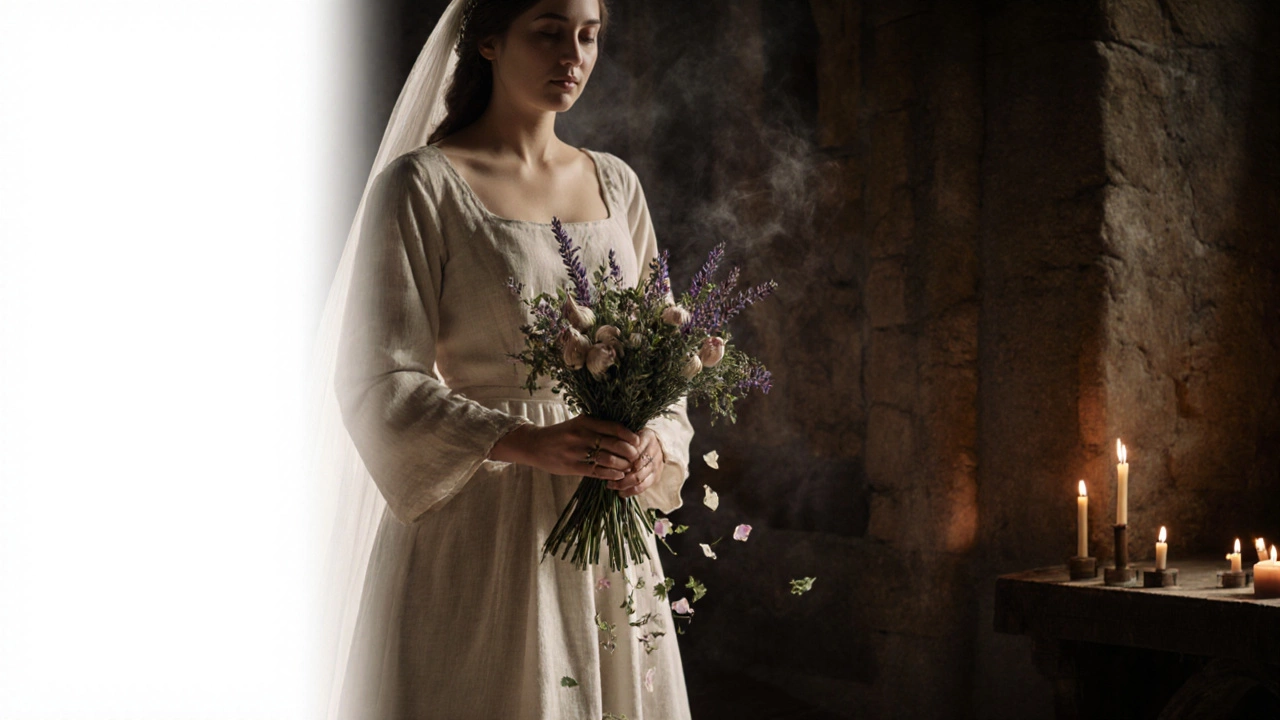Ever watched a bride walk down the aisle, petals drifting around her like snow, and wondered why she’s carrying flowers at all? It’s not just about looking pretty. The tradition goes back centuries - and it’s got more to do with survival than style.
Flowers Were Originally for Protection
Long before Pinterest boards and floral arches, brides carried bundles of herbs and flowers not for beauty, but for protection. In ancient Rome and Egypt, people believed strong-smelling plants like garlic, dill, and thyme could ward off evil spirits. Weddings were seen as vulnerable moments - a woman leaving her family, a new union forming - and superstition ruled. Brides carried these bundles to keep bad luck away. The scent masked body odor in an era without deodorant, but more importantly, it was spiritual armor.
By the Middle Ages, this evolved into tight bouquets called "nosegays" - small, dense clusters of herbs and flowers. These weren’t just decorative. They were functional. People didn’t bathe often. Crowded churches smelled like sweat, smoke, and unwashed wool. A nosegay tucked under the arm was a personal air freshener and a shield against disease. Plague outbreaks in Europe made people extra cautious. Strong-smelling blooms like rosemary and lavender were thought to purify the air. So yes - your bouquet started as a survival tool.
The Shift From Function to Symbolism
By the 1700s, as hygiene improved and society became more refined, the practical need for smelly herbs faded. But the symbolism stuck. Flowers began to stand for something deeper. In Victorian England, where flower language (floriography) was a full-blown cultural code, every bloom carried meaning. A red rose meant love. White lilies stood for purity. Orange blossoms symbolized fertility. A bride’s bouquet became a secret message - whispered in petals.
Queen Victoria’s wedding in 1840 cemented the trend. She carried a bouquet of orange blossoms, myrtle, and ivy. Orange blossoms were rare and expensive, signaling wealth. Myrtle was a family heirloom, tied to love and marriage. Her choice wasn’t random - it was a statement. The press covered it endlessly. Suddenly, every bride in Europe and America wanted to copy her. Flowers weren’t just for smell anymore - they were for status, for story, for symbolism.
Why the Aisle? Why Not Just Hold Them?
Walking down the aisle with flowers isn’t arbitrary. It’s ritual. The aisle is the transition point - from single life to married life. The flowers are carried forward, literally and symbolically. They lead the way. In some cultures, the bride’s bouquet was thrown to guests at the end of the ceremony to pass on good luck. That’s where the modern bouquet toss came from. But the act of carrying them down the aisle? That’s about intention.
Think of it like a torch. The bride holds something beautiful, fragrant, alive - and walks through a space filled with people watching her change. The flowers mark her journey. They’re not just decoration. They’re part of the performance. Even today, brides choose flowers that reflect their personality - wildflowers for free spirits, roses for classic romance, peonies for abundance. The bouquet is an extension of her story.

Modern Brides Still Follow the Tradition - Even If They Don’t Know Why
Today, most brides don’t think about plague prevention or Victorian flower codes. They pick flowers because they look good in photos. They match their dress. They match the venue. But the deeper roots are still there. When a bride walks down the aisle with a bouquet, she’s continuing a chain that goes back 2,000 years - from Roman herbs to Victorian codes to Instagram-worthy arrangements.
Some brides now skip flowers entirely. They carry books, candles, or even their dog. But even those who choose alternatives are still playing into the same ritual: marking a moment with something meaningful in hand. The flowers, whether real or symbolic, are a bridge between old and new.
What Flowers Mean Today - And How to Choose
While the old meanings aren’t strictly followed anymore, many brides still pick blooms with intention. Here’s what’s popular now:
- Roses - timeless love. Red for passion, white for purity, blush for grace.
- Peaches and Peonies - abundance, prosperity, and a soft, romantic feel.
- Orchids - elegance and strength. Often chosen by brides who want something modern and bold.
- Sunflowers - happiness and loyalty. Popular in rustic or outdoor weddings.
- Wildflowers - freedom, natural beauty. Favored by boho or eco-conscious brides.
Some brides even include a "something old" flower - a sprig from their mother’s bouquet, or a bloom from their grandmother’s garden. It’s not tradition for tradition’s sake. It’s connection.

It’s Not Just About the Bride
Flowers down the aisle aren’t just for the bride. They’re part of a larger visual language. The groom’s boutonniere matches the bouquet. Bridesmaids carry smaller versions. The aisle is lined with petals or arrangements. It’s all connected. This isn’t decoration for decoration’s sake. It’s cohesion. It tells guests: this day is intentional. Every detail is chosen. Every step matters.
Even the color of the flowers carries weight. White was once the only option - purity, innocence. Now, brides choose blush, ivory, even deep burgundy. Each color tells a different story. And the flowers? They’re still the first thing people notice.
Why This Tradition Endures
At its core, the reason brides walk down the aisle with flowers isn’t about fashion. It’s about meaning. Humans need rituals. We need symbols to mark big moments. Flowers are alive. They change. They fade. And so does the day - the laughter, the tears, the vows. The bouquet becomes a keepsake. A tangible piece of a fleeting moment.
It’s not about the cost. It’s not about trends. It’s about carrying something beautiful into your next chapter - just like generations before you did, whether they knew it or not.
Why do brides carry flowers instead of something else?
Brides carry flowers because they’re a living symbol - beautiful, fragrant, and temporary. They’ve been used for thousands of years to ward off evil, mask smells, and now, to express emotion. While other items like books or candles are becoming popular, flowers still feel most connected to the emotional weight of the moment. They’re soft, natural, and universally understood as symbols of love and new beginnings.
Do all cultures carry flowers down the aisle?
Not all. In some East Asian traditions, brides carry fans or red umbrellas for luck. In parts of India, brides wear garlands of marigolds around their necks, not carry bouquets. In Jewish weddings, the bride often walks under a canopy with no flowers at all. The aisle bouquet is mostly a Western tradition, rooted in European customs. But even in cultures without bouquets, flowers often play a role - just in different forms.
Can I walk down the aisle without flowers?
Absolutely. More brides are choosing alternatives - a single book, a lantern, a family heirloom, or even nothing at all. The aisle isn’t about the object - it’s about the intention. If you feel more connected to something else, go with it. Your wedding is yours. Tradition is a guide, not a rule.
What’s the difference between a bridal bouquet and a bridesmaid’s bouquet?
The bridal bouquet is usually larger, more elaborate, and often includes the bride’s favorite blooms or symbolic flowers. Bridesmaid bouquets are smaller, simpler, and designed to complement - not compete. They’re coordinated in color and style, but intentionally less dominant. Think of it like a spotlight: the bride is the center, and the bridesmaids support her.
Why are white flowers so common in weddings?
White became popular after Queen Victoria wore a white gown and carried white flowers in 1840. Before that, brides wore their best dress - often colored. White symbolized wealth (since it was hard to keep clean) and purity. Today, white flowers still feel classic and timeless, but they’re no longer required. Many brides now mix in pastels, greens, or even dark blooms for contrast.
